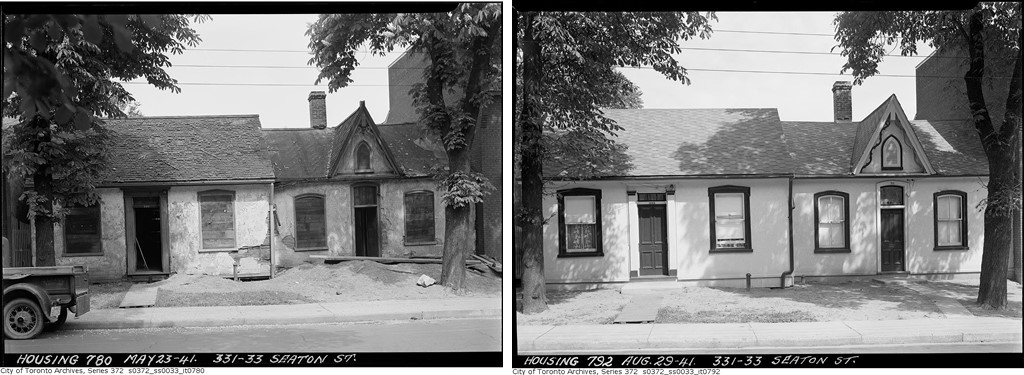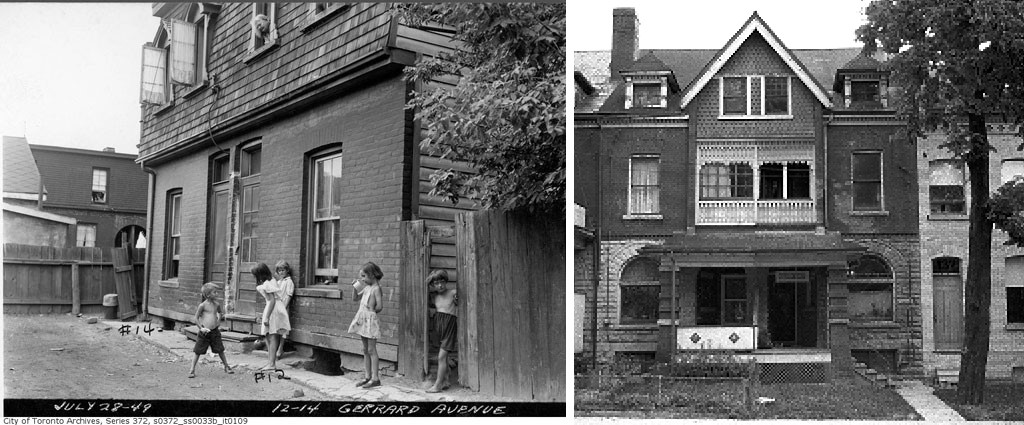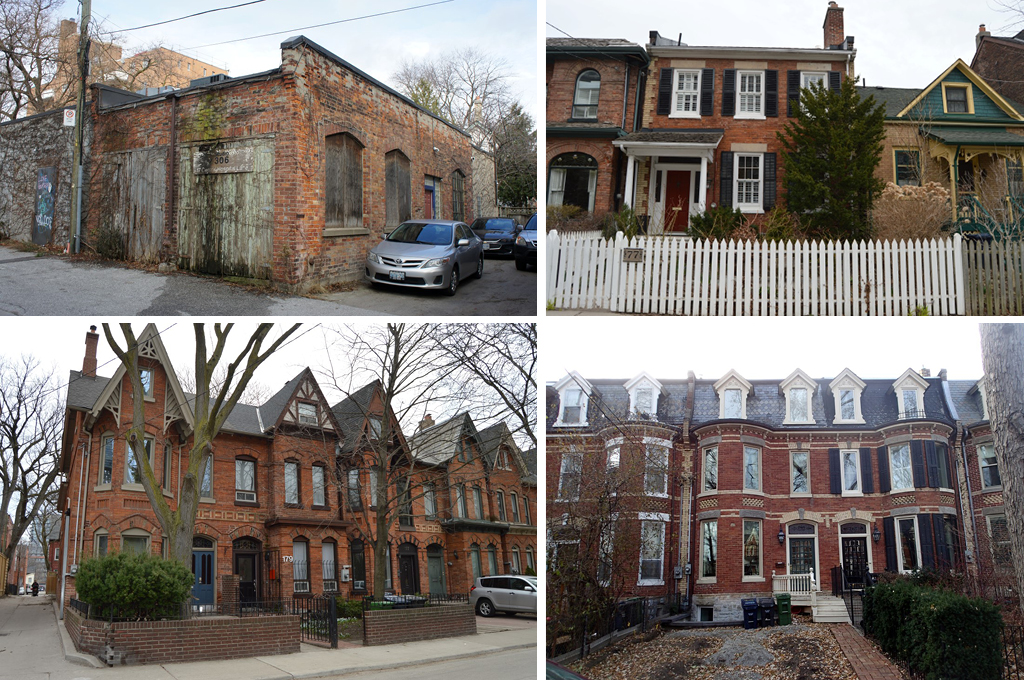Location: Toronto
Date of Completion: Area developed from the 1840s onwards
Architect: Various
Nominated by: Suze Morrison, MPP (Toronto Centre)
“They built up the city in a personal sense, in a way that has hardly been built since, for they did their own building.”
-J.V. McAree, Cabbagetown Store
Known for its remarkable collection of Victorian residential buildings and orderly tree-lined streets, the seemingly consistent architectural character of this downtown Toronto neighbourhood hides a dynamic story of transformation, change, and diversity—each new generation providing a new chapter to the area’s history.
Immigrant working-class beginnings
Located just outside the newly incorporated City of Toronto, Cabbagetown first developed in the 1840s as river-abutting park lots—large, rectangular parcels of land acquired by landed gentry—were progressively subdivided and sold to small developers. The adjacency to the then-marshy Don Valley made this area unattractive to much of Toronto’s middle class, so developers instead built housing for the steady influx of working-class immigrants arriving to the city in the late 19th century, many of whom worked in industries adjacent to the river and waterfront. The name of the area presumably comes from the cabbages and other ground vegetables that were planted by Irish and Eastern Europeans in their front yards.
As the city grew, so did Cabbagetown’s population. Many were drawn to the area due to its proximity to employment opportunities at the large factories nearby. While industrialists flaunted their wealth by building mansions along the new arteries that would define the boundaries of this burgeoning neighbourhood, the working class was relegated to the narrower, interior streets that were lined with more modest homes with simpler finishes. Many of the original residential buildings are balloon-framed—a wood construction method that meant that houses could be built quickly and cheaply.

“Worker’s cottages” are a common sight in Cabbagetown, and were decorated and renovated over time to suit the tastes of their inhabitants. Photos courtesy of the Toronto Archives.
Changing identities
With the Great Depression and its financial impact on the working class, Cabbagetown’s built form began to change, reflecting the struggles of its residents. Many of the original buildings began to fall into disrepair and houses were increasingly subdivided to accommodate multiple families under one roof. The area was the subject of a well-known piece of Canadian fiction written by Hugh Gardner, who chronicled the lives of youth in what was described as “the largest Anglo-Saxon slum in North America.” The decades following the Depression would see little new development in the area, and much of the original neighbourhood was razed in the late 1940s as part of the urban renewal project known as Regent Park.
By the 1970s, urban renewal projects had gone out of style and there was strong political support for the preservation of the inner city’s original fabric. Instead, a process of gentrification slowly unfolded throughout Cabbagetown, partly due to people who established queer institutions in the area, attracted by affordable properties and accessible rents. Prominent institutions of the Gay Liberation movement such as Glad Day Bookshop and The Body Politic were founded in the neighbourhood, while The Canadian Gay and Lesbian Archives (now known as the ArQuives) were first housed in a basement on Seaton Street.
While this process has led to the restoration and upgrade of many of Cabbagetown's famous Victorian homes, it has also displaced many of its original residents and organizations that once called the area home, as property prices continue to rise. Still, the neighbourhood continues to be the site of many rooming houses which represent an important portion of the city’s remaining stock of affordable housing. The retention of these rooming houses is in large part thanks to many community groups, such as Dixon Hall, which continue to work to maintain and improve existing rooming houses in the neighbourhood.
 Cabbagetown has been home to may children over the years (left), as well as being the birthplace of well-known Toronto institutions such as the Glad Day Bookstore (right). Photos courtesy of the Toronto Archives.
Cabbagetown has been home to may children over the years (left), as well as being the birthplace of well-known Toronto institutions such as the Glad Day Bookstore (right). Photos courtesy of the Toronto Archives.
A showroom for Victorian residential architecture
Cabbagetown is perhaps best known for its collection of Victorian residential architecture, considered one of the largest in North America. Victorian architecture is not a style, but instead a group of styles that were in vogue during the reign of Queen Victoria (1837-1901) when much of Cabbagetown was built. As a result, it has four Heritage Conservation Districts (HCDs) within its borders, with a fifth one in development. HCDs are a municipal planning tool established in the Ontario Heritage Act that provide place-based policies to help conserve the collective heritage value and inform future growth in historic neighbourhoods.
 Cabbagetown’s preserved buildings showcase a variety of architectural styles popular in the Victorian era, from modest laneway coach houses (top-left) to larger, more imposing Georgian Revival (top-right), Bay-and-Gable (bottom-left), and Second Empire (bottom-right) homes. Photos by EVOQ Architecture courtesy of the City of Toronto.
Cabbagetown’s preserved buildings showcase a variety of architectural styles popular in the Victorian era, from modest laneway coach houses (top-left) to larger, more imposing Georgian Revival (top-right), Bay-and-Gable (bottom-left), and Second Empire (bottom-right) homes. Photos by EVOQ Architecture courtesy of the City of Toronto.
Many of the styles captured within Victorian architecture were revival-styles, recalling elements of past movements—often combining multiple styles within a single building. Cabbagetown’s houses display a mix of various influences, pointing to what was popular (and/or easily available) at the time. From small, “worker’s cottages” with details such as barge boarding and finials, to larger, multiple-story homes with Mansard roofs and Italianate windows, these buildings resoundingly proclaim that the many fashions and decorative elements that helped define Victorian architecture were not always congruous, but resulted in facades that intrigue to this day.
While Cabbagetown’s historic fabric can sometimes make the neighbourhood feel like a stable institution, the true character of Cabbagetown comes not from uniformity, but from its ability to respond and adapt to changing times and the needs of its residents.
The OAA would like to thank Alex Corey, Senior Heritage Planner at the City of Toronto, for his contributions to making this article possible.
This post forms part of our World Architecture Day Queen’s Park Picks 2020 series in which we asked Ontario’s Members of Provincial Parliament to nominate a prominent building, past or present, in their riding for a chance to learn more about it. Check out the rest of the series to learn more about great buildings across the province!